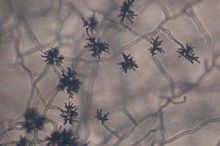Cladosporium
| Cladosporium | |
|---|---|

| |
| Scientific classification | |
| Kingdom: | |
| Division: | |
| Class: | |
| Order: | |
| Family: | |
| Genus: | Cladosporium[1] |
| Species | |
|
Cladosporium arthropodii | |
Cladosporium is a genus of fungi including some of the most common indoor and outdoor molds. Species produce olive-green to brown or black colonies, and have dark-pigmented conidia that are formed in simple or branching chains.
The many species of Cladosporium are commonly found on living and dead plant material. Some species are plant pathogens, others parasitize other fungi. Cladosporium spores are wind-dispersed and they are often extremely abundant in outdoor air. Indoors Cladosporium species may grow on surfaces when moisture is present.
Cladosporium fulvum, cause of tomato leaf mould, has been an important genetic model, in that the genetics of host resistance are understood.[2]
Health effects
Cladosporium species are rarely pathogenic to humans, but have been reported to cause infections of the skin and toenails, as well as sinusitis and pulmonary infections. If left untreated, these infections could turn into respiratory infections like pneumonia.
The airborne spores of Cladosporium species are significant allergens, and in large amounts they can severely affect asthmatics and people with respiratory diseases. Cladosporium species produce no major mycotoxins of concern, but do produce volatile organic compounds (VOCs) associated with odours.
References
- ^ Schoch CL, Shoemaker RA, Seifert KA, Hambleton S, Spatafora JW, Crous PW. (2006). "A multigene phylogeny of the Dothideomycetes using four nuclear loci" (PDF). Mycologia. 98 (6): 1041–52. doi:10.3852/mycologia.98.6.1041. PMID 17486979.
{{cite journal}}: CS1 maint: multiple names: authors list (link) - ^ Rivas, S. & Thomas C.M., 2005. Molecular interactions between tomato and the leaf mold pathogen: Cladosporium fulvum. Annual Review of Phytopathology 43: 395-436.
"Prolonged exposure may weaken the immune system" - this statement is nonsense and should be removed, or reference given to explain it.
